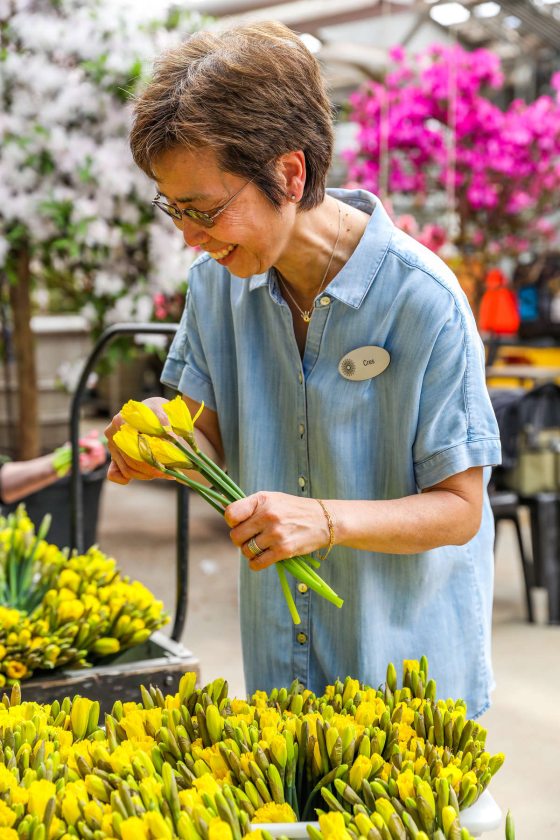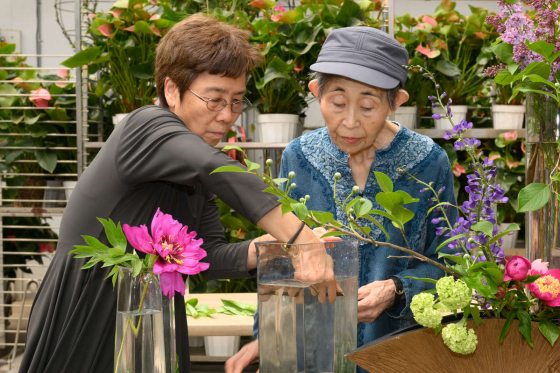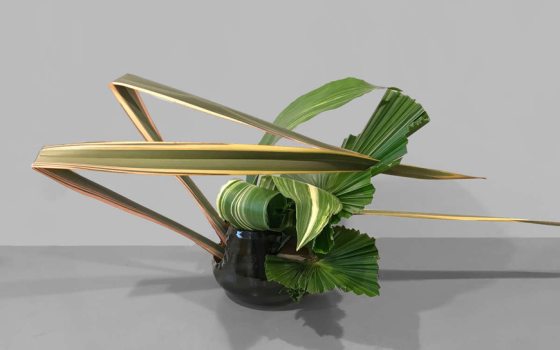Editor’s Note: Floral designer Cres Motzi, AIFD serves as a Longwood Gardens Continuing Education instructor. Motzi is a graduate of Longwood’s Certificate of Merit in Floral Design, as well as a Sogetsu Ikebana teacher, 4th grade.
What is Ikebana? Ikebana—ike meaning arrange, bana meaning flower—is not about following a set of rules and making a pretty arrangement. It is a mindset and attitude of appreciating nature and its beauty, and then bringing that natural beauty indoors. To some, the word conjures up images of highly stylized floral designs from the East; to others it may mean arranging flowers according to strict rules. To me, at least initially, it was a source of frustration … but ultimately evolved into a source of perspective and a practice in patience.
Being a native of Hong Kong, Ikebana is not unfamiliar to me. I remember catching glimpses of several Ikebana presentations, although I had little interest in the art form at the time. Years later when I was reacquainted with Ikebana through the Certificate of Merit in Floral Design program at Longwood, I cannot say that I embraced the art form at the outset. I had already fallen in love with western-style flower arranging. There was not enough room in my heart to take on Ikebana too.

The main reason for my hesitation might have been my struggle with grasping Ikebana’s concepts and techniques. Perhaps you can relate—I was scissors-happy and trimmed too many leaves while I practiced. A once full and beautiful branch became a forlorn, bare stick; the first two main stems leaned too far back, and the arrangement looked unbalanced and tipsy. Instead of using the supporting stems to artfully cover the kenzan (a spiky Ikebana tool for fixing the flowers in the container), the base of the arrangement looked stuffed and the kenzan could still be seen. I didn’t understand why I couldn’t utilize a tall container, so that plant materials looked elegantly arranged or simply remain in their relative positions. It was only flowers and branches … arranging them should not be so frustrating, I thought.

I took the proverbial path of less resistance and focused my energy on the study and practice of western-style floral design. I was happily navigating through my floral design adventures until one summer when I encountered Ikebana again. Soho Sakai, AIFD, Riji, presented a stage program at the AIFD National Symposium. To say that I was wowed by her designs would be an understatement. I remember thinking that I wanted to be able to create designs like hers. And so it began … a renewed chapter for me in Ikebana, specifically Sogetsu Ikebana.
Ikebana originated with temple worship. Today it is practiced widely in Japan and across the globe. There are many schools of Ikebana. The most widely known schools in the US are Ichiyo, Ikenobo, Ohara, and Sogetsu. Each school has its own emphasis or approach to flower arranging. Ikenobo, being the very first school since the 15th century, has its traditions in religious ceremonies and offerings. Sogetsu, having celebrated its 90th anniversary in 2017, is relatively “new.” Sogetsu founder Sofu Teshigahara felt that the rules of Ikebana were too restrictive and did not allow for an individual’s freedom of expression. He broke from traditional Ikebana and established his own school in 1927. One of his favorite sayings has become the motto of the school: “Sogetsu Ikebana can be created anytime, anywhere, by anyone in any part of the world, and with any kind of material.” How could anyone not be encouraged by such a statement to take up the art form!

I wish I could say relearning the basics was a piece of cake. It was not! It helped that I had an excellent teacher in Longwood Continuing Education instructor Midori Tanimune, Komon. Perhaps it was wisdom from age and experience; I was more able to put everything in perspective and allow myself the luxury of not getting something right the first time, the second time, the third time, or so forth. Practice does make perfect … just ask any accomplished artist or musician.

A branch or a flower is beautiful in and of itself, but what can be done to accentuate its beauty even more? With Sogetsu Ikebana, we can take the time to study the plant materials and determine the best angle for placement, or judiciously prune a leafy branch to showcase the linear shape and enhance its beauty. By repeatedly doing the basic designs, we learn about asymmetry, space, harmony, line, and mass and hone skills to prepare us for free-style designs, which could be abstract or avant-garde. Practicing basic designs can be challenging, but it ultimately provides the means for us to acquire techniques to artistically express ourselves with any type of material, at any time, in any place. I think it is well worth it.
Explore the beauty of Sogetsu during Blooms & Bamboo: Chrysanthemum and Ikebana Sogetsu Artistry, on view October 3–November 17.
